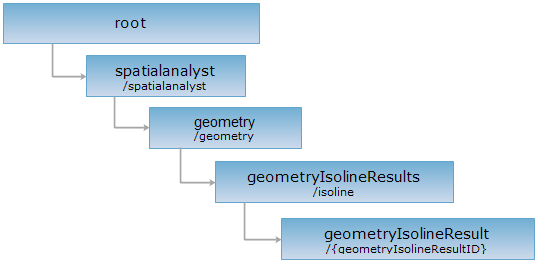URI
<geometryIsolineResults_uri>/{geometryIsolineResultID}[.<format>]
Supported methods
Parent resource
Introduction
Gets isoline extraction result..
Supported methods
- GET: Gets part of isolines extraction result resource.
- HEAD: Checks the existence of the geometryIsolineResult resource, or whether the client has the permission to access the geometryIsolineResult resource.
Supported output formats: rjson, json, html, xml.
GIS Services Resource Hierarchy

HTTP request methods
Implement theHTTP request on the following URI, with rjson being the output format, in which, supermapiserver is the server name.
http://supermapiserver:8090/iserver/services/spatialanalyst-sample/restjsr/spatialanalyst/geometry/isoline/1.rjson
GET request
Gets the result of the isoline extraction.
Response structure
Normal response code(s): 200.
After implementing the GET request, the response parameters are as follows:
| Field | Type | Description |
| succeed | boolean | Whether the spatial analysis is successful. |
|
message |
String | The message returned when the spatial analysis fails. |
| dataset | String | The result dataset identity. |
| recordset | Recordset | The result recordset, used to store spatial object information. When implementing the POST request on the geometryIsoregionResults resource, the spatial object information will be displayed only if dataReturnMode of dataReturnOption is set to Recordset. |
Example usage
Implement the POST request and you will get the result as follows:
{
"dataset": "geoIsoline@Interpolation",
"message": null,
"recordset": null,
"succeed": true
}
HEAD request
Asks for the response identical to the one that would correspond to a GET request, but without the response body. This is useful for retrieving meta-information written in response headers, without having to transport the entire content. The meta-information includes the media-type, content-encoding, transfer-encoding, content-length, etc.
The HEAD request helps check the existence of the geometryIsolineResult resource and whether it can be accessed by the client. By implementing the HEAD request on the URI, with .<format> appended to the end, we can quickly get to know whether the geometryIsolineResult resource supports the representation in <format> or not.